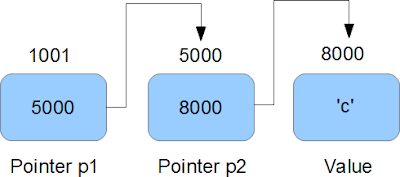Pointers in C++
Introduction to Pointers
o When we declare a variable some memory is
allocated for it. The memory location can be referenced through the identifier
“i”.
Thus, we have two properties for any variable : its address and its data value.
The address of the variable can be accessed through the referencing operator
“&”. “&i” gives the memory location where the data
value for “i” is
stored.
o A pointer variable is one that stores an
address. We can declare pointers as follows int* p; .This means that p stores the address of
a variable of type int.
o Q: Why is it important to declare the type of the variable that a pointer points to? Aren’t all addresses of the same length?
o A: It’s true that all addresses are of the
same length, however when we perform an operation of the type “p++” where “p”
is a pointer variable, for this operation to make sense the compiler needs to
know the data type of the variable “p” points to. If “p” is a character pointer
then “p++” will increment “p” by one byte (typically), if “p” were an integer
pointer its value on “p++” would be incremented by 2 bytes (typically).
o Summary of what was learnt so far:
n Pointer
is a data type that stores addresses, it is declared
as follows: int*
a; char* p; etc.
n The
value stored in a pointer p can be accessed through
the dereferencing operator
“*”.
n The
address of a memory location of a variable can be
accessed through the
reference operator “&”.
n Pointer
arithmetic: only addition and subtraction are
allowed.
Pointers and Arrays
o The concept of array is very similar to the
concept of pointer. The identifier of an array actually a pointer that holds
the address of the first element of the array.
o Therefore if you have two declarations as
follows:
n “int a[10];” “int*
p;” then the assignment “p = a;” is
perfectly valid
n Also
“*(a+4)” and “a[4]” are equivalent as
are “*
(p+4)” and “p[4]” .
n The
only difference between the two is that we can change the value of “p” to any
integer variable address whereas “a” will always point to the integer array of
length 10 defined.
o The concept of array is very similar to the
concept of pointer. The identifier of an array actually a pointer that holds
the address of the first element of the array.
o Therefore if you have two declarations as
follows:
n “int a[10];” “int*
p;” then the assignment “p =
a;” is perfectly valid
n Also
“*(a+4)” and “a[4]” are equivalent as
are
“*(p+4)” and “p[4]” .
n The
only difference between the two is that we can change the value of “p” to any
integer variable address whereas “a” will always point to the integer array of
length 10 defined.
Character Pointers, Arrays and Strings
o What is a String?
n A
string is a character array that is ‘\0’ terminated.
n E.g.
“Hello”
o What is a Character array?
n It
is an array of characters, not necessarily ‘\0’ terminated
n E.g.
char test[4] = {‘a’, ‘b’, ‘c’, ‘d’}; <this
char array is not zero terminated>
o What is a character pointer?
n It
is a pointer to the address of a character variable.
n E.g.
char* a; <this pointer is not initialized>
o How do we initialize a Character pointer
n Initialize
it to NULL. char* a = NULL;
n Let
it point to a character array.
o char*
a; char b[100]; a = b
n Initialize
to a character string.
o char*
a = “Hello”; a pointer to the memory location where ‘H’ is stored. Here “a” can be viewed as a
character array of size 6, the only difference being that a can be reassigned
another memory location.
Examples
o char* a = “Hello”;
n a
-> gives address of ‘H’
n *a
-> gives ‘H’
n a[0]
-> gives ‘H’
n a++
-> gives address of ‘e’
n *a++
-> gives ‘e’
n a =
&b; where b is another char variable
is perfectly LEGAL. However “char a[100];” “a =&b;” where b is another char
variable is ILLEGAL.











0 comments:
Post a Comment